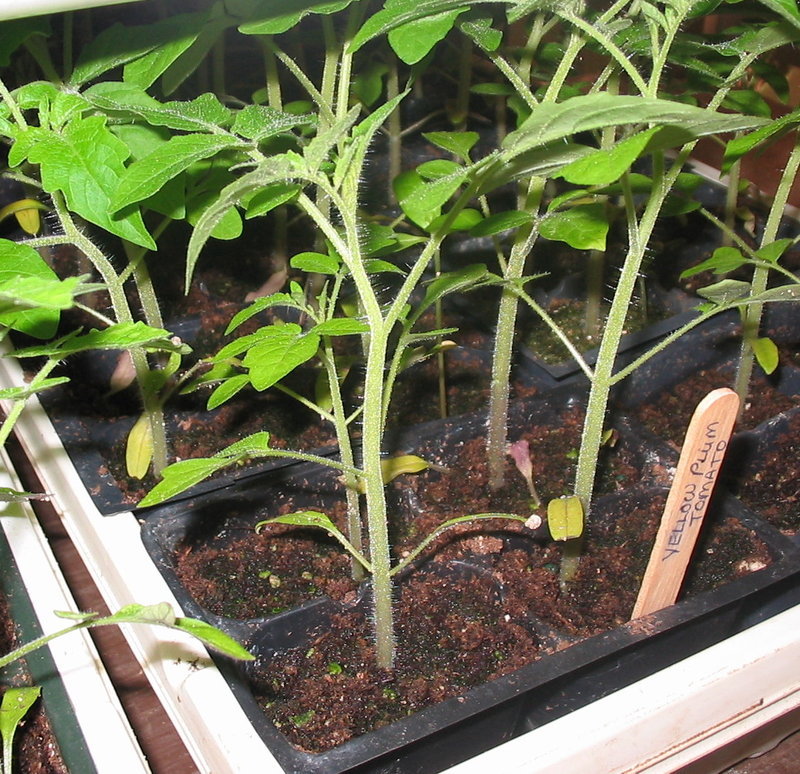Keeping Your Indoor Seedlings Compact

Bob Wildfong
If you have started seeds indoors for your garden, you have taken the first step in a great adventure to take full control of what you grow. Many people purchase seedlings in the spring, because they are easier to grow, and that's fine, but the diversity available in seedlings pales in comparison to the vast diversity available in seeds. To an experienced gardener, seeds represent the full range of choices from commercial companies and from the growing number of seed savers offering home-saved seeds.
Seeds want to grow, so they just need the right place to do it. A warm, well-lit place with good soil and even moisture. A windowsill is a great place to start, and when you need a bit more room a shelf with a light fixture attached above it will give good results. Once you have the watering schedule figured out (not too much, not too little) there is usually just one vexing problem left: what to do with long, spindly seedlings.
Seedlings grow long, thin stems when they don't have enough light. In nature, they might just be shaded underneath another plant, so they try to grow tall to reach above it. Unfortunately that doesn't help them in your windowsill, so they just grow long, weak stems. Sometimes the fragile stems break, and almost always, the seedlings become difficult to separate and transplant into the garden.
My two favourite solutions (besides building a greenhouse to get more light in the first place) are to transplant the seedlings to bury the excess stems, or to prune them to keep them short.
Transplanting Seedlings
When a seedling grows too tall and spindly, it is not very difficult to transplant it into a deeper pot, burying part of the stem. You might have heard that garden plants and especially trees should not be transplanted deeper than they've become accustomed to, which is true for large plants, but seedlings don't mind being buried a few inches deeper. As long as most of the leaves are above ground, this is a good way to get rid of excess stem length and make the seedling "shorter" in the pot. It will be less likely to break and get intertwined with other seedlings, and ultimately it will be easier to transplant into the garden.
As a bonus, some plants such as tomatoes and peppers will grow additional roots out of the sides of the buried stems. That makes a bigger root mass, and a healthier seedling, while making it more compact.
Pruning Seedlings
Shrubs, trees, and houseplants all respond in much the same way when their branches are pruned: they produce new growth further down the trunks and stems. Seedlings do the same. You can pinch or cut back your seedlings to make them more compact and bushy, keeping them a manageable size, just as you would do with shrubs.
When a seedling grows, usually all the growth is just at the tip. New leaves grow, then a new section of stem, then leaves, and another section of stem. That linear growth is what makes the seedling long and spindly. If you just pinch off the growth tip, the seedling gets confused about where it should put its energy, so it grows new branches all along the stem. That not only stops it from becoming longer and more fragile, it creates a bushier plant in the garden.
Which method is best?
That depends on the plant. I always use the pruning method with zinnias and marigolds whether the seedlings are long or not because it makes a much nicer bushy plant in the garden, with more flowers. When the seedlings reach the five leaf stage, I just chop them off to three leaves. Scissors are good for this.
On the other hand, I don't prune tomato seedlings, ever. The reason is that the bushy growth caused by tip-pruning will make a tomato plant with many more side-branches (we call them "suckers") that make the vines difficult to stake and control. Instead, I use the transplanting method for tomato seedlings, burying their stems so that only the leaves show above ground. The underground stems grow more roots, and the aboveground stems grow stocky and well-behaved.
If you've felt discouraged from growing seedlings indoors because they've been long and untamed, try again and experiment with a few ways to keep them compact. There is nothing like seeing seeds sprout in March, and having the unmatched diversity of seeds available to your garden all summer!
**
Bob Wildfong is Seeds of Diversity's executive director
Not yet a member?
An annual membership to Seeds of Diversity gives you access to our seed exchange, seed grow-out programs, and our online news.

We depend on donations to do our work.

Thank you for your support!
